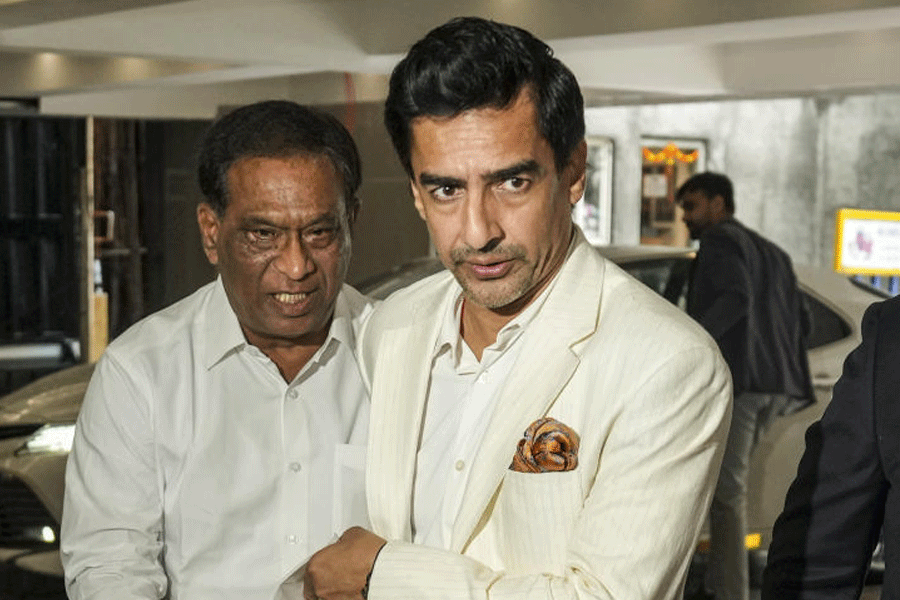 |
 |
 |
| CAPTIVE TALENT: (From top) Campus recruitment in progress at Tihar jail; Rabindranath Tagore’s play Valmiki Pratibha being staged by the inmates of Presidency Jail, Calcutta, and an art class in the same jail |
It’s been little over a year at the Alipore Central Jail for Venkateshwar Reddy, known as Telugu Deepak, the alleged chief of the Maoist guerrilla wing in Bengal. But it doesn’t seem that he is greatly worried about the war being waged by his comrades against the State.
Instead, Reddy is happy wielding a brush. “He’s been busy learning painting and has done pretty well,” says B.D. Sharma, inspector general of correctional services, West Bengal. “He has also shown an interest in learning Sanskrit. We have provided him with a teacher,” he adds.
These days, jails are bustling with creativity. Across the country, undertrials and convicts are nurturing latent talents — and earning money and prestige in the process. Charcoal sketches and oil paintings by Baby John Parkar, an undertrial in Maharashtra’s Nashik jail, exhibited in Mumbai recently, fetched him Rs 2 lakh. Paintings by prisoners at the Tihar jail in Delhi won awards at an international competition in Vienna last year.
“Keeping prisoners busy by involving them in activities such as gardening and jail factories is a thing of the past. Now we are looking at reform with theatre, music, painting and vocational skills,” says Sunil Gupta, public relations officer, Tihar Central Jail, which has also identified talented cricketers to be trained under former Test player Rajinder Pal.
The buzzword in correctional homes these days is therapy — through culture, creative arts, sports, yoga and education. The idea is not just to keep prisoners busy but to encourage them to pick a stream that may help them earn their livelihoods once released. Inmates undergo free courses to pick up subjects of interest.
Tihar is selling apparel, designer footwear, paintings, handmade paper, bakery products and other items produced by its inmates under the brand name TJ’s. TJ’s also has its own website (www.tihartj.nic.in) and outlets within court complexes in Delhi. Jail authorities say they will soon approach supermarkets and malls to display TJ’s products on their shelves. “Big Bazaar, Spencer’s, etc. are on our radar. Our products are as good as others’,” says Gupta.
Swati Mehrotra, a Delhi-based footwear designer who also runs a free footwear designing school in Tihar, vouches for that. “Some of the best designs I have come across have been by the prisoners. In fact the fastest selling footwear in my store is the TJ’s brand,” says Mehrotra.
In fact, Mehrotra intends to hire two inmates once they are out of jail. “The two, who joined my footwear designing class at Tihar, caught my eye with their creativity and also their presentation skills,” she adds.
Gone are those days when the image of a jailed inmate was that of a man breaking stones in shackles. These days, as jails go in for better living conditions and other reforms, the dignity of prisoners is being upheld with the help of creative activities. “The recognition that these artists get from the prison system and outside can allow them to lead dignified lives,” says Swati Sathe, superintendent, Nashik jail.
Sharma agrees. When prisoners take part in plays or other such activities, he is often warned of security threats. “But I have always been confident of our prisoners. When they get a standing ovation wherever they go, why would they even think of doing anything foolish,” asks Sharma. According to him, one of the most cherished moments for the prisoners was when they staged Rabindranath Tagore’s Balmiki Pratibha at Santiniketan, Tagore’s centre of learning in Bengal. “It was an experience that everyone treasures to this day,” Sharma stresses.
Nigel Akkara, a former prisoner at the Presidency Correctional Home who donned the role of Ratnakar (a dacoit who shuns violence to become Valmiki, the poet), says it changed his life. “Initially it was a way of passing time. But now the play is a part of my life. I became a different person when I went on stage,” says Akkara, who runs a small business in Calcutta.
Akkara employs around 15 of his former jailmates in his organisation, the Calcutta Services Company. “I am yet to get a single complaint against any of them,” says a proud Akkara.
Creative activities also prompt former prisoners to stay away from crime once they are out of jail. A few years ago, authorities say, about 35 per cent of Delhi’s former inmates returned to crime. Now, with jail reforms changing lives, only about 20 per cent do so.
One of the more popular extra-curricular activities is hairstyling. Introducing this stream in prisons, says hairstylist Amzad Habib, was a “masterstroke” on the part of the Tihar jail authorities. Habib, who runs a free three-month hairstyling course within the jail, says it has been a “life-changing” experience for him too.
“You will not believe the kind of talent the prisoners have, especially the youngsters. Their creative side was never exploited and now, with a bit of help, they know their own worth,” says Habib, who has trained around 60 prisoners in hairstyling.
Habib’s academy also gives them certificates without mentioning the place of training. “I wish our society was mature enough to accept former prisoners. But since that is not the case, we merely mention that the person is qualified to be a hairstylist. I have heard that quite a few are doing pretty well after serving their terms,” says Habib.
It was because of these initiatives of the Tihar jail that companies lined up when a placement camp was organised recently for prisoners whose jail terms were about to end. Sixteen people, recruited by companies such as the Vedanta group and Aggarwal Movers and Packers, are expected to join work once they are released from jail.
“Initially we found it difficult to convince companies to recruit prison inmates. But they agreed after we stood as guarantors for their good conduct,” says Bharat Vaswani of Vedanta Foundation, which helped bring the companies and prisoners together.
Vaswani stresses that one of the best ways of reforming inmates is by “empowering” them with employment. “We hope to negotiate with other jails across the country and launch such employment initiatives.”
The authorities in Madhya Pradesh have chosen a different path to reform. Harendra Singh, superintendent, Central Jail, Gwalior, says the authorities introduced a yoga instructors’ course last year for the prisoners. “About 150 people have been given certificates. Some were released well before their jail terms and some have gone on to become yoga instructors,” he says.
Now other jails are following the example of Gwalior, which hopes to train around 400 prisoners to become yoga instructors this year.
Jail administrators say incidents such as prison riots, violent disputes among prisoners and smuggling of drugs have come down in recent years. “Of course, security measures, including close-circuit television cameras, have been increased, but you cannot discount the positive changes in the prisoners,” says Gupta.
But, of course, not all is hunky dory within the high walls. Whether it is Tihar, Alipore or Gwalior, prisons are teeming with inmates. Tihar has a capacity to house 6,250 prisoners but 11,000 people are in jail. Gwalior holds around 2,000 prisoners, double its capacity.
Prison authorities say these problems will be resolved soon. “Even a few years ago, jail reforms in India were moving at the pace of a tonga. Now changes are occurring at the speed of the Shatabdi Express,” says Gupta.
Habib quotes a line from Sholay — made famous by the actor Dharmendra — to make his point. “It is no longer chakki-peesing (grinding wheat) in jails. It’s about improving oneself.”










